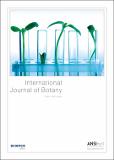| dc.contributor.author | S Sikolia, JC Onyango, E Beck, JI Kinyamario | |
| dc.date.accessioned | 2020-08-13T10:45:40Z | |
| dc.date.available | 2020-08-13T10:45:40Z | |
| dc.date.issued | 2009 | |
| dc.identifier.citation | 8 | en_US |
| dc.identifier.issn | 1811-9700 | |
| dc.identifier.uri | https://repository.maseno.ac.ke/handle/123456789/2076 | |
| dc.description | The article can be accessed in full text via URL;https://www.cabdirect.org | en_US |
| dc.description.abstract | Two hundred and seventy eight species of the Centrospermeae were collected at different sites in Western Kenya representing gradients of altitude and aridity. Climate data were obtained from meteorological research stations. Species were examined for C3 or C4 photosynthesis using the anatomical Kranz syndrome, δ13C values and carbon dioxide compensation points. C4 photosynthesis is a feature of modern members of dicotyledoneae is of multiple evolutionary origins. It evolved independently in members of the same family and was found in one to several genera and then often only with two to three species. C4 species are concentrated in lowland habitats subjected to high temperature, low precipitation and high evaporation. High δ13C values is associated with low water availability which is a physiological syndrome and also a feature of saline habitats. The C3 representatives of the Centrospermeae dominate in more moist and colder habitats, especially at higher altitudes. Only a few C4 species occur at high altitudes (3000-4000 m) namely Sagina gallica, Silene abyssinica and Melandrium nordiflorum. The transition zone between C3 and C4-dicot is rather narrow between 1500 to 1700 m and thus much lower than that recorded for the monocots (2000-2200 m). The general pattern of δ13C values distribution along the altitudinal gradient show that the values of -10.60 to -16.55, -17.75 to -18.87 and -18.89 to -32.42 per mil that corresponds to altitudinal ranges, 0-1500, 1550-1700 and 1800-4200 m, respectively. The low altitudes are associated with drought and high temperatures. C4 and C3 dicot species can be intercropped to increase bioproductivity for the betterment of the flora and fauna in the semi-arid and arid ecosystem. C4-species are potential candidates for exploitation in the agroforestry systems especially for long-term management programmes. The present study may also be relevant for better understanding of global change with respect to the diversity of photosynthetic pathways, herbivory and vegetation dynamics. | en_US |
| dc.publisher | ANSInet, Asian Network for Scientific Information | en_US |
| dc.subject | Climatic factors;Altitude;Transition zones;ecological significances;C4 and C3 Photosynthetic species | en_US |
| dc.title | The distribution of C3 and C4 photosynthetic species of the Centrospermeae along an altitudinal gradient in Western Kenya. | en_US |
| dc.type | Article | en_US |

